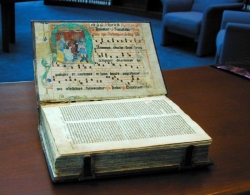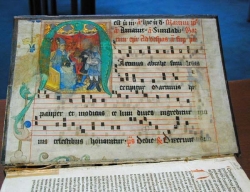
A few medieval and early modern manuscripts are owned by Gonzaga University. In addition are many valuable facsimiles of manuscripts.
Portions of medieval manuscripts are found as "pastedowns" in Gonzaga's oldest printed books, incunabula. The practice of fifteenth-century printers was to recycle leaves from manuscripts as facings for the inside of the covers of printed books. Perhaps the oldest of these "pasted down" manuscript leaves at Gonzaga is a leaf from a martyrology dated to 1290. It is the back pastedown in the 1490 edition of the Summa Theologica of Antoninus.
  |
|
|
Antiphonary leaves from the thirteenth or fourteenth century are found as pastedowns in the Bruno Psalter of 1475. |
Two complete seventeenth century manuscripts on Aristotle are part of The Gonzaga Collection. Notably, each is on a "template book," a printed blank book prepared by stationers for students to use for taking notes for a course or for scholars to use when preparing a manuscript for publication. Gonzaga owns one of each type, and each template book is rather elegant, with marbled endpapers and an engraved frontispiece or title page. Thus these volumes have additional interest as attesting a little studied aspect of the history of the book.
From 1670 is the reportatio of the student John Middleton. A reportatio is a transcription of a series of lectures. Middleton wrote this autograph manuscript in a ready-made volume: a bound, prepared block of pages with marbled end pages and edges, engraved frontispiece and ornamented form for the titlepage and with ruling lines on the block of pages. This template book includes a frontispiece: a bust portrait of Aristotle in an oval frame inscribed: PHILOSOPHUS ARISTOTELES HOMO GRÆCUS. The French caption is biographical: "Aristote prince des Peripateticiens et j.er de tous les Philosophes eut pour pere Nicomacus medicin. Il fut precepteur d’alexandre le grand qui luj porta une si grande affection, qu’a sa seule consideration il retablit sa patrie, qu’il avoit ruinée. Enfin il mourit aagé de soixante et huict ans, la mesme année que mourut Demostene apres avoir escrit plus de trois cent tomes. [signed:] B.M. avec p." The book concludes with a usual colophon: "Finis undecimo die Maii Anno Domini 1670 Joannes Middleton." The next page is headed "Index Disputorum ac Quæstionum Quæ In hoc Libro Continent[u]r," but Middleton did not compile an index.
Probably the Jesuit scholar Ioanne Baptiste de Fourmestraulx is the author of the 1693 commentary on Aristotle's physics entitled Liber summus phisicorum. Fourmestraulx wrote this autograph manuscript in a ready-made volume with ruling lines on the block of pages and with marbled endpapers. Although this volume lacks a frontispiece, it has an engraved illustrated border for the titlepage, consisting of ten bust portraits with names inscribed. In the top row are "Aristoteles, Thomas [Aquinas], Plato"; on the left side: "Seneca, Socrates"; on the right side: "Pythagoras, Epicurus"; and in the bottom row: "Erasmes, Porphyruis [!], Diogenes."